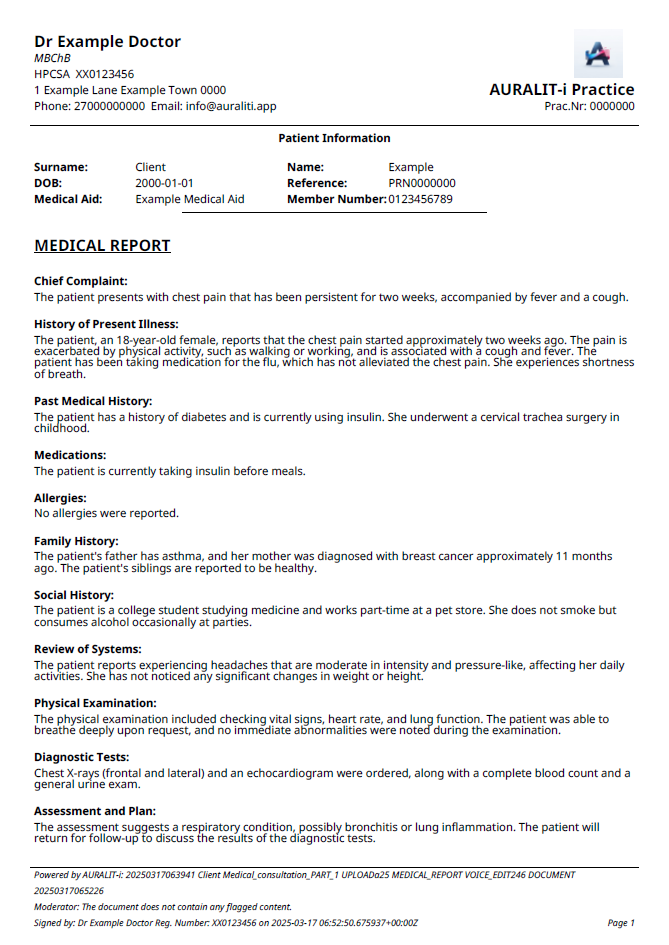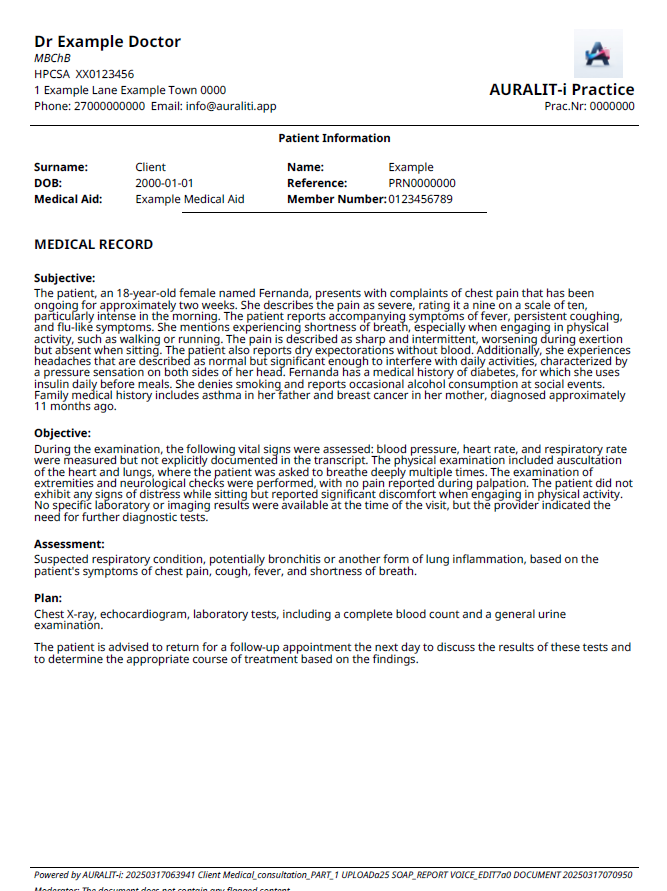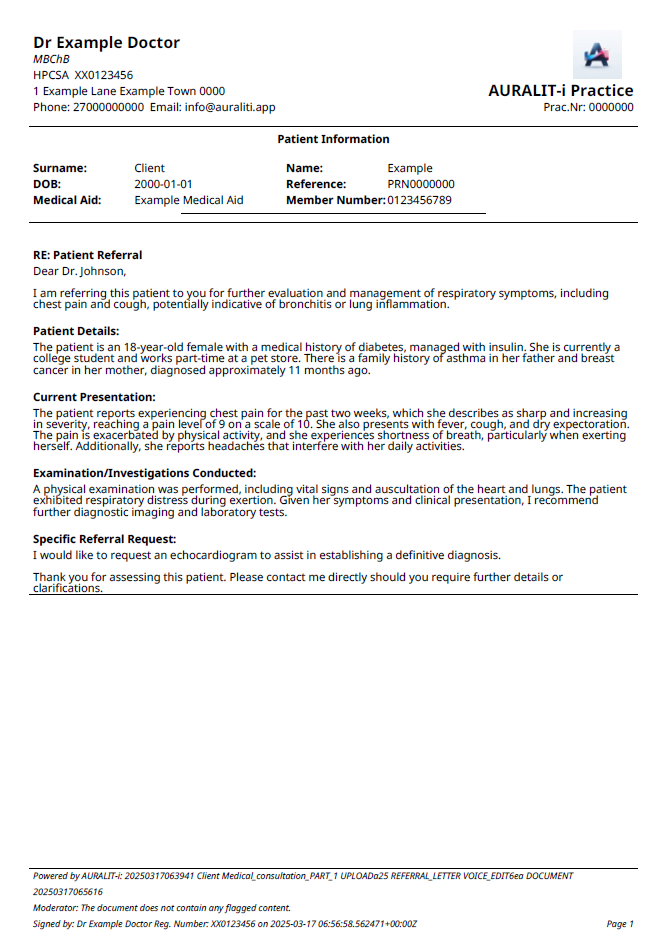Document Information
Detailed descriptions, sample reports and tips on generating excellent reports.
This section summarises how Auraliti turns speech or uploaded text into polished healthcare documents. It also lists universal tips that apply to every template.
What Information it Includes:
- List of all supported document types and their ideal use-cases
- Overview of common formatting rules applied by the AI
- Best-practice dictation advice for clear, complete transcripts
- Links to sample outputs for every template
How to improve
- Speak steadily & clearly: minimise background noise and avoid two people talking at once.
- Use cues or headings: saying “Subjective”, “Plan”, “Allergies”, etc. helps the model slot facts into the correct section.
- Spell unusual drug names: or state both brand and generic to avoid transcription errors.
- Pause between sections: a one-second break dramatically improves automatic segmentation.
For conversational input:
- Summarise key points aloud: e.g., “Let me recap your main symptoms …”. This reinforces accuracy for patient and model.
- Give explicit time references: “started three days ago”, “in 2018” rather than “a while back”.
- State units with numbers: e.g., “milligrams”, “beats per minute”, “centimetres”.
- End with the plan & follow-up: a clear closure helps the AI detect next-step instructions.
Frequently Asked Questions
A structured, single-visit surgical consultation note that captures the reason for referral, focused history, condition-specific risk factors, a precise physical examination, relevant investigations, multidisciplinary discussion (if any), and a clear management plan. Optimised for breast and thyroid/parathyroid referrals but suitable for a broad range of general-surgery presentations.
What Information it Includes:
- Consultation metadata (date, referring clinician(s), etc
- Patient demographics (age, sex where stated)
- Presenting complaint with onset, duration, site/laterality and red-flag features
- Condition-specific background (breast, thyroid/parathyroid)
- Relevant past medical and surgical history
- Current medications and allergies
- Family history of malignancy or other relevant inherited conditions
- Lifestyle & psychosocial context that affects peri-operative risk
- Detailed examination findings
- Investigations
- MDT discussion summary and action points (if applicable)
- Risk factors and prognostic features (explicitly stated)
- Assessment / succinct clinical impression and ICD-10 codes if provided
- Management plan including systemic therapy, surgical plan, referrals, supportive care and follow-up
How to improve
- Begin with a concise referral reason: e.g., “Right breast lump referred by GP 2 weeks” — this frames the whole consult.
- State laterality & exact location: clock-face, quadrant, or distance from nipple for breast notes.
- Give dates for investigations: e.g., “Mammogram 2024-02-03” or “FNA January 2023” to link results precisely.
- When mentioning family history, list relation & age if known: “Mother: breast cancer at 48”.
- Speak pathology & imaging results verbatim: include grade, receptor status, and BI-RADS if available.
For conversational input:
- Narrate key physical findings aloud: “3 cm firm mass upper outer quadrant, mobile, no skin tethering”.
- Read out relevant labs and values: “TSH 2.1 mIU/L on 2024-03-01” — avoids transcription gaps.
- State planned next steps during the consult: saying “we will request neck ultrasound and endocrine tests” records intent clearly.
Frequently Asked Questions
A complete consultation-and-procedure note for botulinum-toxin treatments. It captures the patient’s aesthetic goals, facial assessment, informed consent, detailed injection log and post-procedure instructions.
What Information it Includes:
- Consultation context (date, provider, chaperone)
- Patient’s aesthetic goals & chief concerns
- Past cosmetic procedures and relevant medical history
- Skin / facial assessment and Fitzpatrick type
- Treatment plan (product brand, target muscles, planned units)
- Documented informed consent & patient education
- Step-by-step injection log with lot / batch numbers
- Immediate outcome, adverse events, after-care advice
- Follow-up schedule and emergency contact instructions
How to improve
- Speak units & sites clearly: e.g., “4 units each to L/R corrugator, 2 units procerus”.
- Spell lot and batch numbers to avoid transcription errors.
- State consent explicitly: “Written consent obtained after risks discussed”.
- Include after-care verbatim: the model will mirror your exact instructions.
For conversational input:
- Confirm goals aloud: “You’d like softer glabellar lines before your wedding in six weeks—correct?”
- Narrate technique in real time: call out needle gauge, depth and muscle as you inject.
- Describe immediate outcome: bruising, patient comfort, any complications.
Frequently Asked Questions
A single concise paragraph (≤ 10 sentences) that captures the essence of an encounter—presenting complaint, salient findings, impression, management and follow-up. Ideal for quick handoffs, messaging or adding a synopsis at the top of the chart.
What Information it Includes:
- Presenting complaint & short history
- Key exam, lab or imaging findings
- Impression / assessment
- Treatment given or planned
- Follow-up instructions
How to improve
- Prioritise importance: mention the main problem first; omit trivia.
- Use concrete numbers: “BP 150/95”, “WBC 14 × 109/L”.
- End with follow-up: specify timeframe (“review in 48 h”).
For conversational input:
- Flag section changes aloud: e.g., “Assessment: likely viral sinusitis”.
- Give time anchors: “three-day history”, “last dose this morning”.
Frequently Asked Questions
An in-depth, hierarchical report covering everything from chief complaint to referrals. Mirrors a full internal-medicine work-up—perfect for new-patient intakes or complex cases that need granular detail.
What Information it Includes:
- Demographics & source of referral
- Full history (medical, surgical, psychosocial)
- Systematic Review of Systems
- Physical examination by organ system
- Clinical summary, problem list, differentials
- Investigations, plan & referrals
How to improve
- Signal headings verbally: saying “Past Medical History” improves accuracy.
- Include dates & control status: e.g., “Type 2 diabetes, diagnosed 2015, HbA1c 7.8%”.
- Delete redundancies: the model drops any empty headings automatically.
For conversational input:
- Ask clarifying questions aloud: their answers populate the right heading.
- Summarise problem list verbally before moving to the plan.
Frequently Asked Questions
Comprehensive second-visit note that bridges the initial ‘Comprehensive Medical Report’ with the current encounter. It pulls forward the prior summary, reviews progress on the last plan, documents today’s findings and sets a refreshed roadmap.
What Information it Includes:
- Quoted / paraphrased summary from the previous consultation
- Patient feedback on treatment, adherence and side-effects
- Status of investigations and actions ordered last time
- Updated examination findings (with comparison to baseline)
- Results reviewed today and new tests ordered
- Current working diagnoses / problem list
- Revised management plan (meds, referrals, lifestyle)
- Scheduled follow-up interval & safety-net advice
How to improve
- Compare to baseline: use phrases like “BP down from 160/100 → 138/88”.
- Tick off prior actions: state which labs or imaging were completed or still pending.
- Highlight adherence: e.g., “Patient took 90 % of prescribed doses”.
For conversational input:
- Ask explicitly about each plan element: “Did you manage to reduce salt intake?”—the answer feeds the ‘Patient Feedback’ section.
- Restate new adjustments aloud: helps the AI capture exact dose changes.
Frequently Asked Questions
A streamlined progress note for third and subsequent visits. It focuses on interval change, problem-list monitoring and rapid plan adjustments while still referencing key elements from the previous report.
What Information it Includes:
- One-sentence recap of the most recent visit
- Interval events: new symptoms, flares, hospitalisations
- Medication adherence & side-effects since last review
- Targeted vitals / focused exam with comparison to prior values
- Labs or imaging reviewed today (with status of any pending)
- Updated problem list (resolved, stable, worsening)
- Brief plan tweaks (meds, tests, lifestyle advice)
- Next follow-up timing & red-flag advice
How to improve
- Stay problem-oriented: update each active issue rather than re-telling the whole story.
- Use objective data: “Weight +1.2 kg”, “HbA1c now 7.1 %”.
For conversational input:
- Confirm interval events aloud: e.g., “Any ER visits since we last met?”
- State plan changes explicitly: “Increase Lisinopril from 10 mg to 20 mg daily”.
Frequently Asked Questions
Structured note for psychological, career, marital or other counselling sessions. Captures presenting concerns, interventions, insights and next steps.
What Information it Includes:
- Session details (type, modality, session #)
- Presenting concern in client’s own words
- Observations of mood, affect and behaviour
- Interventions/techniques used
- Recommendations & follow-up
How to improve
- Quote client sparingly: use direct quotes only when therapeutically salient.
- Note modality changes: e.g., switched from CBT to MI this session.
For conversational input:
- Verbalise interventions: saying “We practised guided imagery” ensures inclusion.
Frequently Asked Questions
Concise inpatient progress note focusing on overnight events, objective data, assessment and plan—designed for ward rounds or ICU reviews.
What Information it Includes:
- Interval history / overnight events
- Latest vitals, labs or imaging
- Updated assessment / problem list
- Plan – orders, investigations, discharge criteria
How to improve
- Use time stamps: “02:00 – hypotension episode”.
- Trend data: e.g., “Creatinine down from 2.1 → 1.8 mg/dL”.
For conversational input:
- Read out new orders aloud so they populate the plan.
Frequently Asked Questions
Summarises a patient’s entire admission: presentation, hospital course, medications at discharge and follow-up arrangements. Suitable for sending to primary care providers or attaching to discharge packs.
What Information it Includes:
- Hospital & ward details, dates
- Key clinical events & procedures
- Ongoing management & red-flag advice
- Full discharge medication list
- Follow-up appointments & referrals
How to improve
- Highlight medication changes: say “NEW”, “STOPPED”, “CONTINUED”.
- Include pending results: flag them for the next provider.
For conversational input:
- Confirm destination aloud: e.g., “going home with district nurse review”.
Frequently Asked Questions
Detailed first-day admission document capturing referral context, HPI, focused ROS, exam, initial investigations and management orders.
What Information it Includes:
- ED / referral handover and triage info
- Full HPI & focused system review
- Comorbidities, meds, allergies, social history
- Initial physical exam & investigations
- Provisional diagnoses & immediate orders
How to improve
- State triage category: helps justify admission level.
- Mention STAT orders: e.g., “fluids started, 1 L NS”.
For conversational input:
- Verbalise risk scores: CURB-65, Wells, etc., if calculated.
Frequently Asked Questions
A comprehensive report capturing patient details such as chief complaint, medical history, examination findings, diagnostics, and treatment plans. Ideal for general consultations, follow-ups, and documenting patient encounters.
What Information it Includes:
- Chief complaint and history of present illness (HPI)
- Relevant past medical & surgical history
- Medications, allergies, family and social history
- Examination details, investigations & treatment plan
How to improve
- Be condition-specific: e.g., “RLQ tenderness 8/10 on palpation”.
- Use standard medical terminology to enhance clarity.
For conversational input:
- Restate key negatives: “No fever, no vomiting”.
Frequently Asked Questions
A factual account of circumstances, clinical course and cause of death designed for internal audit, family communication or coroner documentation.
What Information it Includes:
- Circumstances & time of death
- Brief clinical course & complications
- Cause of death (primary & contributing)
- Resuscitation attempts / interventions
- Family communication & certification details
How to improve
- Be chronological: state events leading to death in order.
- Use official terminology: e.g., “cardiorespiratory arrest”.
For conversational input:
- Include pronouncing time aloud for accurate certification.
Frequently Asked Questions
An exhaustive neuropsychological evaluation covering clinical interview, multi-domain cognitive testing, personality inventory and integrated recommendations—suitable for differential diagnosis of TBI, dementia, ADHD and more.
What Information it Includes:
- Identifying data & test battery list
- Reason for referral and presenting concerns
- Detailed background interview (medical, psychiatric, education, occupation)
- Behavioural & clinical observations during testing
- Domain-specific test results with norms and interpretation
- PAI validity and clinical scales (if administered)
- Integrated summary of cognitive profile and functional impact
- Targeted recommendations, accommodations and referrals
- Referenced literature or normative manuals (if cited)
How to improve
- Name each test and version: e.g., “WAIS-IV Digit Span, scaled score = 8 (Low Average)”.
- Give normative descriptors: Average, Borderline, Impaired, etc., for each domain.
- State performance-validity results: helps establish test reliability.
- Include behavioural nuances: frustration tolerance, effort, distractibility.
For conversational input:
- Read raw & scaled scores aloud as you review each subtest.
- Summarise domain interpretations: e.g., “Visuo-motor speed falls in the Low Average range”.
- State concrete recommendations: accommodations, cognitive rehab, further referrals.
Frequently Asked Questions
A holistic assessment covering symptom burden, goals-of-care discussions, psychosocial and spiritual needs, and an interdisciplinary management plan.
What Information it Includes:
- Encounter details & ICD-10 codes
- Symptom inventory with severity scores
- Goals-of-care conversation elements
- Physical, psychosocial & spiritual assessments
- Comprehensive care plan & follow-up
How to improve
- Quantify symptoms: give 0-10 scores for pain, dyspnoea, etc.
- State ECOG level: helps with prognostication.
For conversational input:
- Repeat patient’s goals aloud to verify understanding.
Frequently Asked Questions
Short, problem-focused update for ongoing palliative-care patients—tracks symptom changes, psychosocial issues and plan adjustments.
What Information it Includes:
- Updated symptom scores
- New psychosocial concerns
- Goals-of-care review
- Medication tweaks & other interventions
How to improve
- Compare to previous visit: e.g., pain 7 → 4.
For conversational input:
- Confirm breakthrough doses used: helps dose adjustments.
Frequently Asked Questions
A plain-language leaflet that explains the diagnosis, key findings, treatment plan and self-care instructions directly to the patient.
What Information it Includes:
- Simple explanation of condition
- Lay summary of findings
- Why treatment matters
- Medication & lifestyle instructions
- Red-flag warnings & follow-up
How to improve
- Avoid jargon: define unavoidable terms in brackets.
- Use second-person: speak directly to the patient (“you”).
For conversational input:
- Check understanding aloud: patient questions often reveal what to include.
Frequently Asked Questions
Outlines functional baseline, therapy goals, interventions delivered and progression criteria—ideal for PT, OT or rehab settings.
What Information it Includes:
- Baseline mobility & pain levels
- Short- and long-term functional goals
- Therapeutic exercises & modalities used
- Home exercise / progression plan
- Follow-up schedule
How to improve
- State measurable goals: e.g., “walk 20 m with quad cane”.
- Give dosage of exercises: reps, sets, hold time.
For conversational input:
- Demonstrate & verbalise: describe each exercise aloud while showing.
Frequently Asked Questions
Pre-anaesthetic evaluation covering indication, risk stratification, airway, planned procedure and pre-op orders.
What Information it Includes:
- Surgical indication & planned procedure
- ASA class & comorbidities
- Airway assessment & prior anaesthetic issues
- Risk factors (bleeding, nutrition, etc.)
- Pre-op orders (NPO, meds, prophylaxis)
How to improve
- Quote airway scores: Mallampati, thyromental distance.
- Mention anticoagulants: and stop/continue plan.
For conversational input:
- Confirm consent aloud for documentation.
Frequently Asked Questions
A comprehensive psychological consultation report, capturing presenting problem, history, mental status examination, clinical impressions, and recommendations. Essential for documenting evaluations and treatment planning.
What Information it Includes:
- Presenting problem & history
- MSE observations
- Psychological assessments & scores
- Formulation & diagnostic impressions
- Treatment recommendations
How to improve
- Include direct client quotes for key statements only.
For conversational input:
- Articulate MSE aloud during observation.
Frequently Asked Questions
Structured imaging report covering study details, technique, findings, impression and recommendations—applicable to XR, CT, MRI, ultrasound and more.
What Information it Includes:
- Study details & indication
- Acquisition technique / contrast
- Systematic description of findings
- Diagnostic impression
- Recommendations or follow-up imaging
How to improve
- State modality and body part first for clarity.
- Provide measurements: lesion size, distance, etc.
For conversational input:
- Use standard lexicons aloud: BI-RADS, LI-RADS when applicable.
Frequently Asked Questions
Operative note detailing background, technique, intra-operative events and post-op considerations—suitable for theatre records or case publications.
What Information it Includes:
- Background & objectives
- Pre-operative considerations
- Step-by-step surgical technique
- Immediate outcome & complications
- Post-operative plan & prospects
How to improve
- Describe key steps plainly: “Medial parapatellar approach…”.
- Note instrumentation & implants: size, serial no. if relevant.
For conversational input:
- State complications in real time: e.g., “small serosal tear repaired”.
Frequently Asked Questions
Captures details unique to remote encounters—platform, connectivity, remote examination limitations—in addition to standard HPI, assessment and plan.
What Information it Includes:
- Platform, consent & technical notes
- Presenting concerns & HPI
- Remote examination findings / limitations
- Investigations reviewed
- Assessment, plan & safety-net advice
How to improve
- Mention technical issues: lag, poor video, device battery.
- Document location of both parties: regulatory requirement.
For conversational input:
- Ask patient to read vitals aloud and repeat them clearly.
Frequently Asked Questions
A structured SOAP (Subjective, Objective, Assessment, Plan) medical note—ideal for progress notes, daily rounds and outpatient visits.
What Information it Includes:
- Subjective section – patient’s words & symptoms
- Objective section – vitals, exam, investigations
- Assessment – diagnoses & differentials
- Plan – treatment, referrals, follow-up
How to improve
- Separate S & O: avoid mixing patient quotes with exam data.
For conversational input:
- Verbalise your assessment: share your thinking process.
Frequently Asked Questions
A formal letter to another healthcare provider, summarising the patient’s condition and the reason for referral.
What Information it Includes:
- Patient background & relevant history
- Current presentation & investigations
- Specific referral request & urgency
How to improve
- State the question clearly: e.g., “opinion on suitability for TAVI”.
For conversational input:
- Tell patient you are referring them: this cue triggers the letter template.









